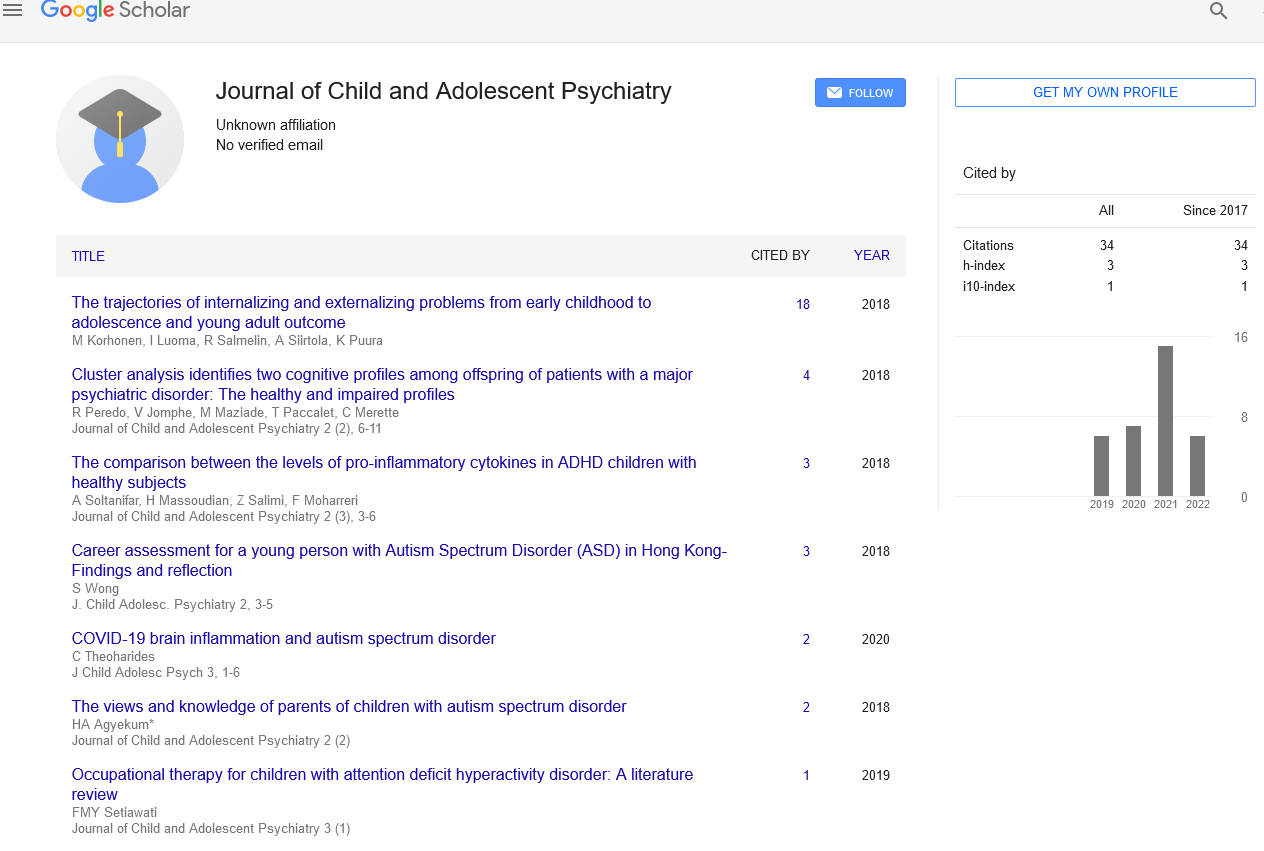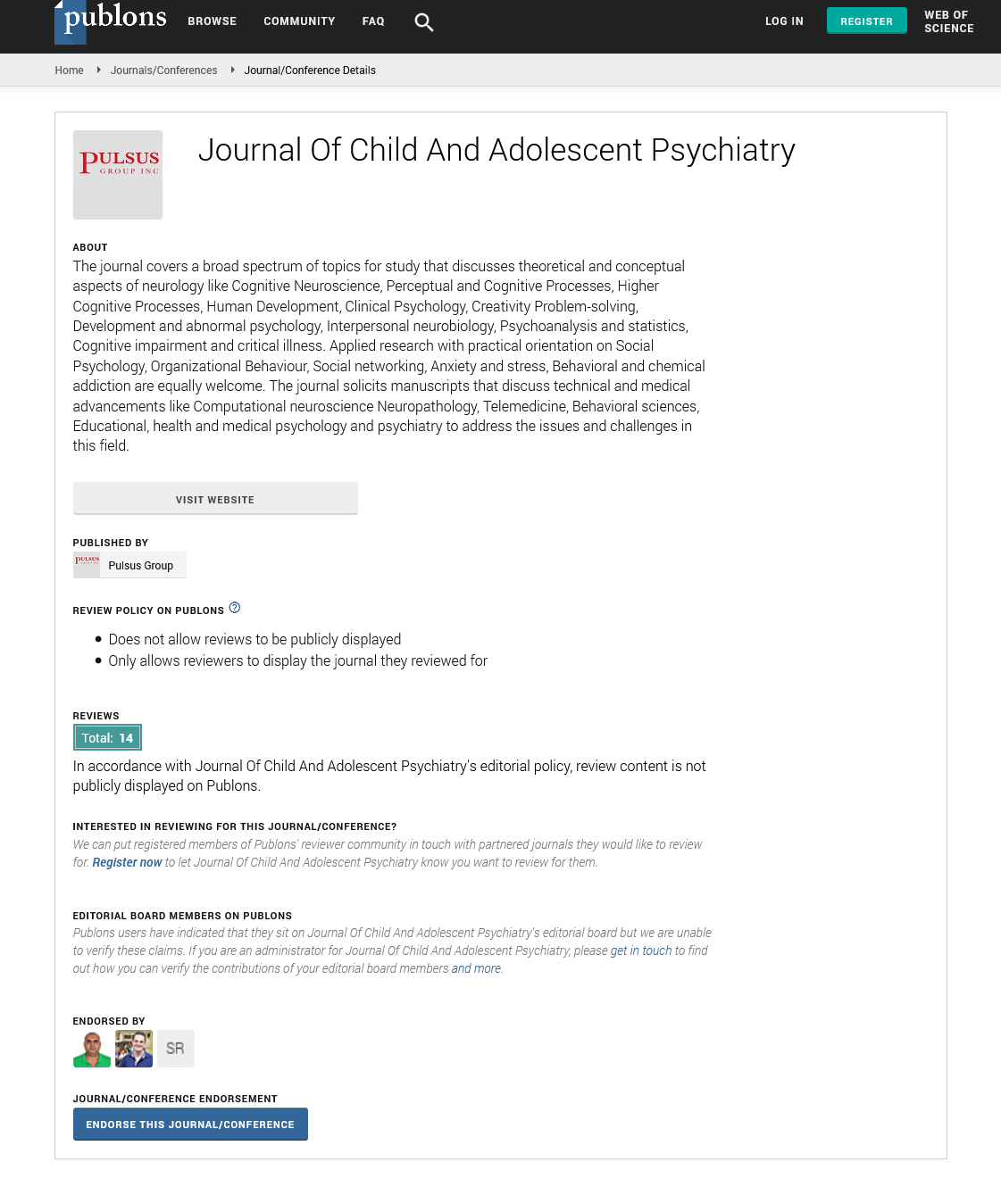Childhood schizophrenia and its effects
Received: 07-Jul-2021 Accepted Date: Jul 21, 2021; Published: 28-Jul-2021
Citation: James J. Childhood schizophrenia and its effects. Child Adolesc Psych 2021;5(3):1.
This open-access article is distributed under the terms of the Creative Commons Attribution Non-Commercial License (CC BY-NC) (http://creativecommons.org/licenses/by-nc/4.0/), which permits reuse, distribution and reproduction of the article, provided that the original work is properly cited and the reuse is restricted to noncommercial purposes. For commercial reuse, contact reprints@pulsus.com
Description
Youth schizophrenia (otherwise called adolescence beginning schizophrenia, and beginning stage schizophrenia) is basically something very similar in qualities as schizophrenia that creates at a later age, yet has a beginning before the age of 13, and is more hard to diagnose Schizophrenia is described by sure indications that can incorporate pipedreams, dreams, and disrupted discourse; negative side effects, like blunted effect and a volition and lack of concern, and various psychological impairments. Differential analysis is hazardous since a few other neurodevelopmental messes, including mental imbalance range issue, language issue, and consideration shortfall hyperactivity issue, likewise have signs and manifestations like adolescence beginning schizophrenia.
The problem presents indications like hear-able and visual visualizations, unusual musings or sentiments, and strange conduct, significantly affecting the kid's capacity to work and support typical relational connections. Daydreams are frequently not organized and vague. Among the maniacal side effects found in youth schizophrenia non-verbal hear-able mind flights are the most well-known, and incorporate commotions like shots, thumps, bangs.[citation needed] Other manifestations can incorporate crabbiness, looking for fanciful articles, or low execution. It regularly presents after the time of seven. About half of little youngsters determined to have schizophrenia experience serious neuropsychiatric symptoms. Studies have exhibited that analytic models are like those of grown-up schizophrenia. Neither DSM-5 nor ICD-11 rundown "youth schizophrenia" as a different determination. Finding depends on conduct saw via overseers and, at times relying upon age, self-reports. Youth schizophrenia was not straightforwardly added to the DSM until 1968, when it was added to the DSM-II, which put forward indicative standards like that of grown-up schizophrenia "Schizophrenia, youth type" was a DSM-II analysis with demonstrative code 295.8, identical to "schizophrenic response, youth type" (code 000-x28) in DSM-I. "Schizophrenia, youth type" was effectively taken out from the DSMIII, and in the Appendix C they stated: "there is presently no chance of anticipating which youngsters will foster Schizophrenia as grown-ups". Rather than youth schizophrenia they proposed to utilization of "puerile mental imbalance" (299.0x) and "youth beginning unavoidable formative issue" .
In the DSM-III-R, DSM-IV, DSM-IV-TR, DSM-5 there is no "youth schizophrenia". The reasoning for this methodology was that, since the clinical pictures of grown-up schizophrenia and youth schizophrenia are indistinguishable, youth schizophrenia ought not to be a different disorder. However, the part in schizophrenia's Development and Course in DSM-5, incorporates references to adolescence beginning schizophrenia.
Worldwide classification of diseases
In the International Classification of Diseases eighth amendment (ICD-8) there was a class (295.8) "Other" in the schizophrenia area (295). "Other" incorporates: abnormal types of schizophrenia, juvenile chemical imbalance, schizophrenia, youth type, NOS (Not Otherwise Specified), schizophrenia of determined sort not classifiable under 295.0–295.7, schizophreniform assault or psychosis. Unknown psychoses with beginning explicit to youth (code 299.9) in the International Classification of Diseases ninth update (ICD-9) incorporates "youngster psychosis NOS", "schizophrenia, youth type NOS" and "schizophrenic disorder of youth NOS".
"Youth type schizophrenia" accessible in the Soviet adjusted variant of the ICD-9 (code 299.91) and the Russian adjusted adaptation of the tenth correction ICD-10 (code F20.8xx3). The signs and side effects of youth schizophrenia are almost equivalent to grown-up beginning schizophrenia. The absolute soonest signs that a little youngster may foster schizophrenia are slacks in language and engine improvement. A few youngsters participate in exercises like fluttering the arms or shaking, and may seem restless, confounded, or troublesome consistently. Youngsters may encounter visualizations, yet these are regularly hard to separate from simply typical creative mind or kid play. Visual fantasies are more generally found in kids than in adults It is frequently hard for kids to depict their mind flights or daydreams, making early-onset schizophrenia particularly hard to analyze in the most punctual stages. The psychological capacities of youngsters with schizophrenia may likewise regularly be missing, with 20% of patients showing fringe or full learned disability.






